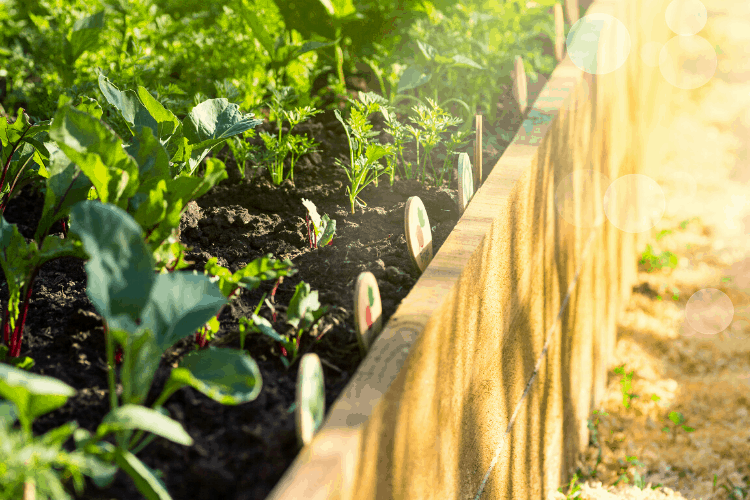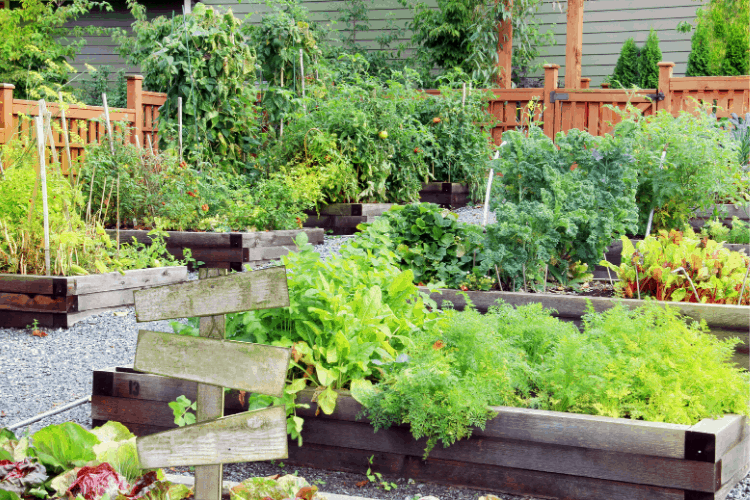If you’re thinking of starting a garden, you’ve likely seen the options for building your own raised beds. There are endless designs, sizes, and also tons of wood choices. However, you want to make sure you pick the right materials to give you the best results. Here are the choices of the best wood for raised bed gardens.
The short answer to the best wood for raised beds is cedar. Cedar can last 15-20 years. But, it’s expensive. Pine is the logical choice for most people when choosing lumber for raised beds. It’s cheap, readily available, but won’t last as long. You can expect 5-7 years before some boards may need to be replaced.

Choosing The Best Wood for Raised Bed Gardens
Wood is certainly not the only option for creating a raised bed garden, but it’s a great choice. When you’re deciding which wood to use for your beds, there are a few key points to think about.
- Cost of the wood
- Durability/longevity of the wood
- Availability
- Size of your garden
When I was researching types of woods, Redwood kept coming up as the best choice. Except, it’s not widely available. So that’s out. Sure it might be great, but it doesn’t matter if you can’t get it easily. Since I’m assuming if you’re reading this, you want to find options that you can get, we’ll move on from Redwood.
For simplicity’s sake, I’m only focusing on Cedar vs Pine for this article though there are many other options out there. The reason for this is that these two are so readily available at garden centers.
Using Cedar for Raised Bed Gardens
There are definite benefits to using Cedar for your garden beds if it’s an option for you.
Pros of using Cedar Wood:
- Cedar will last 10-20 years potentially for your garden beds.
- Naturally rot-resistant
- Resistant to infestations with insects
- Lightweight
- It’s attractive (sounds like a weird description of wood, but it’s a pretty choice)
Cons of Cedar Wood
- Cost – Cedar is significantly more expensive than pine in upfront costs. Of course, if you plan to use these beds for greater than 5-7 years, it could be worth the extra money if you can afford it.
- Availability – this might just be location-specific, but my Lowes and Home Depot do not carry 12″ wide cedar boards. So I would have to buy double the boards to get a garden bed that is 12″ tall.
Using Pine for Raised Bed Gardens
Pine is the second option that we’re focusing on just to keep it simple. Again, there are benefits and cons to each kind of wood. However, I should note that Douglas Fir is a similar choice in to pine in pros, cons, and price (it’s a little more expensive where I live) to using pine.
Pros of Using Pine
- Affordable – this is the biggest factor in my opinion when choosing pine. It is significantly cheaper than cedar.
- Widely available at most garden/home improvement stores
- In my area (may not be the case for your area), it comes in the desired width to build a garden bed that is 12″ high. This reduces the total number of boards by 1/2 compared to building with cedar.
Cons of Using Pine
- Pine will only last between 5-7 years as a garden bed. This can vary depending on your garden and conditions, but generally speaking, you will get around half the life out of pine compared to Cedar
- Pine is not naturally rot-resistant or insect-resistant so you may be fighting decay or pests unlike using cedar.
Price Difference in Pine vs Cedar for Building a Raised Bed Garden
I priced the lumber only at my local home improvement store here in the southern United States. Now keep in mind, your area might stock different sizes of lumber. And my choices of cedar come in two different grades so there was a bit of a price variation.
Another thing when building a raised bed garden is you have endless options for measurements. A general rule of thumb is to not exceed four feet wide to make it easy to reach across your garden. But the length can vary, height is generally anywhere from 10″ to 36″.
Let’s say you want to build a raised garden bed that meets the following dimensions:
- 4 feet wide
- 1 foot deep
- 8 feet long
Cost of the Pine Bed = $25.98 for lumber
This cost reflects only the lumber – three pine boards that are 2x12x8 – I’d use two for the long sides and cut the other to use for the short sides.
Cost of the Cedar Bed = $99.30-$111.42
This cost reflects buying 6 total cedar boards since my local store only sells cedar that is 6″ wide instead of the 12″ I want. You will also need to purchase additional wood to use as braces since you are stacking boards.
Cheapest Option for Building a Wood Raised Garden Bed
Pine is the winner when it comes to choosing the cheapest option for building your wood garden beds. There are drawbacks, but especially if you’re new to gardening, it’s a great choice.
Even if you have to replace the pine boards in 5 years (maybe less depending on your conditions), you can build 4 pine garden beds for the price of one cedar bed.
But, you also have to consider the cost of your time and the hassle of rebuilding your beds when determining your initial investment.
If you’re a beginner, I’d recommend going the $25.98 route for a few reasons. What if you want 2 beds? Then it’s at least $200 on lumber, not to mention the cost of the screws, soil and plants.
Or what if you change your mind and decide you don’t want to continue with it past one growing season (I doubt it, but you never know). It could happen and I’d rather be out a fraction of the cost of cedar.
One thing I’d recommend for beginners is to go with the budget-friendly option first. Figure out if this is a hobby you truly want to continue before investing the big bucks in cedar.
Once you determine that you do want to continue, cedar appears to be the best wood for raised bed gardens if the cost isn’t a deciding factor for you and if you only want to build them once or twice. However, it will add up tremendously compared to pine or fir.
But don’t think you need to wait until you can afford cedar. Just start. Get digging, gardening, growing, and learning!
Either way – choosing the best wood for raised bed gardens is only the beginning of your fun growing journey!
And check out this post about plants that attract butterflies and hummingbirds which can be hugely beneficial to your gardens!

Of course – if you don’t want to build your own, you can look into one of the premade kits like these below:
Pin For Later!










